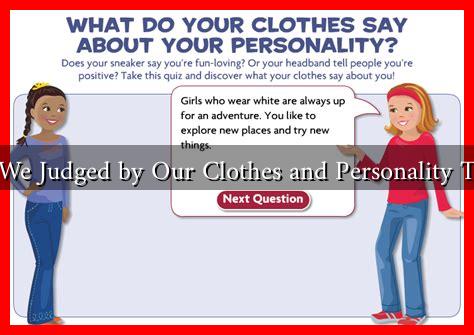-
Table of Contents
Are We Judged by Our Clothes and Personality Traits?
In a world where first impressions are often formed in mere seconds, the age-old adage “you can’t judge a book by its cover” seems to be increasingly challenged. The interplay between our clothing choices and personality traits plays a significant role in how we are perceived by others. This article delves into the psychological and social implications of clothing and personality, exploring how they influence judgments in various contexts.
The Psychology of First Impressions
Research indicates that first impressions are formed within the first 7 to 30 seconds of meeting someone. According to a study published in the journal *Psychological Science*, people can make judgments about a person’s trustworthiness, competence, and likability based solely on their appearance. Clothing is a critical component of this initial assessment.
Clothing as a Social Signal
Clothing serves as a powerful social signal, conveying information about an individual’s personality, social status, and even their values. Here are some ways clothing influences perceptions:
- Professionalism: In professional settings, attire can indicate competence and seriousness. For instance, a well-tailored suit may suggest authority and reliability, while casual wear might be perceived as a lack of ambition.
- Creativity: Unconventional clothing choices, such as vibrant colors or unique styles, can signal creativity and openness to new experiences.
- Conformity: Wearing similar styles to peers can indicate a desire for acceptance and belonging, while distinctive clothing may suggest individuality.
Case Studies and Real-World Examples
Several studies and real-world examples illustrate the impact of clothing on perception:
- The Power of Uniforms: A study by the University of California found that individuals wearing uniforms were perceived as more competent and trustworthy than those in casual attire. This phenomenon is often utilized in professions such as law enforcement and healthcare.
- Job Interviews: Research from the *Journal of Applied Psychology* indicates that candidates dressed in formal attire are more likely to be hired than those in casual clothing, regardless of their qualifications.
- Social Media Influence: In the age of social media, influencers often curate their clothing choices to project specific personality traits, impacting their followers’ perceptions and engagement levels.
The Role of Personality Traits
While clothing plays a significant role in how we are judged, personality traits also contribute to our overall image. The Big Five personality traits—openness, conscientiousness, extraversion, agreeableness, and neuroticism—can influence how we choose our attire and how others perceive us.
Clothing Choices Reflecting Personality
Research suggests that our clothing choices can reflect our personality traits:
- Openness: Individuals high in openness tend to wear more colorful and eclectic clothing, reflecting their creativity and willingness to experiment.
- Conscientiousness: Those who score high in conscientiousness often prefer more structured and formal attire, indicating their organized and responsible nature.
- Extraversion: Extraverts may opt for bold and attention-grabbing outfits, aligning with their outgoing and sociable personality.
Conclusion: The Interplay of Clothing and Personality
In conclusion, the relationship between clothing and personality traits is complex and multifaceted. While we may strive to be judged by our character and abilities, the reality is that our clothing choices significantly influence how we are perceived by others. Understanding this interplay can empower individuals to make conscious choices about their attire, aligning it with their personality and the image they wish to project.
Ultimately, while clothing can provide a snapshot of who we are, it is essential to remember that true character lies beneath the surface. As we navigate social interactions, being aware of the judgments we may face can help us present ourselves authentically while also considering the perceptions of those around us.
For further reading on the psychology of clothing and its impact on perception, you can explore resources from the American Psychological Association here.


